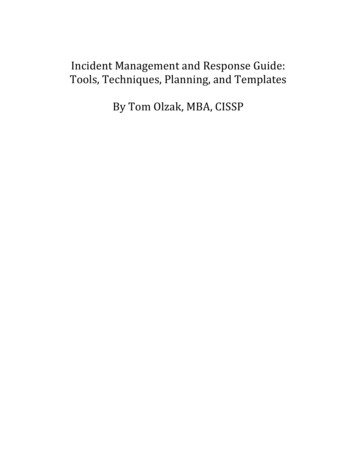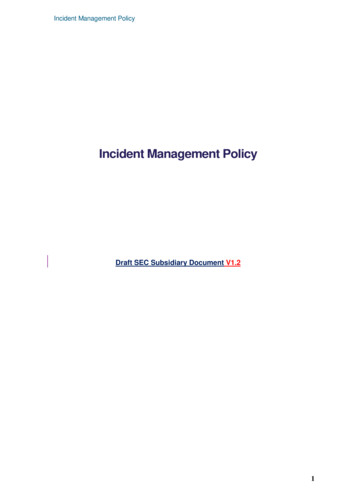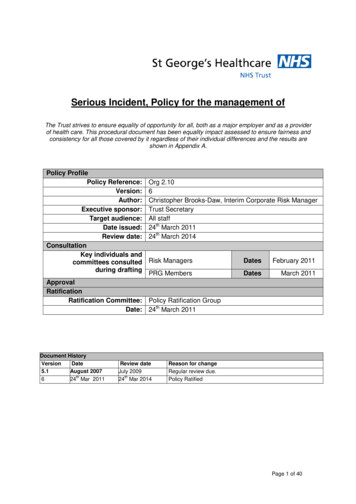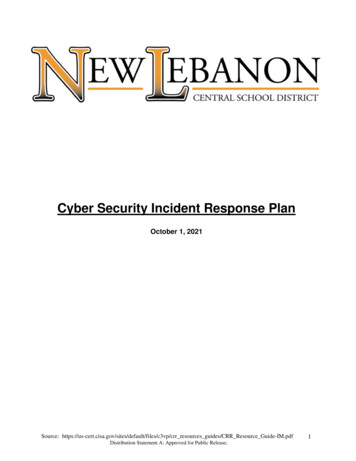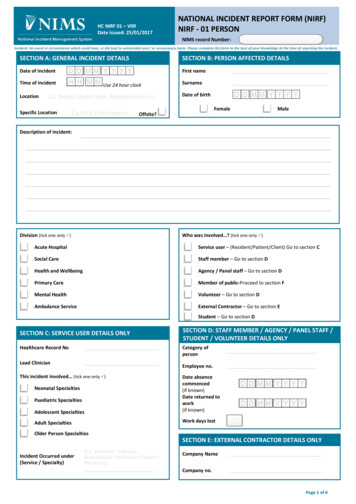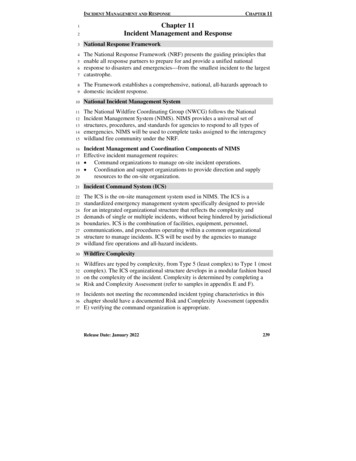
Transcription
INCIDENT MANAGEMENT AND RESPONSE12CHAPTER 11Chapter 11Incident Management and Response3National Response Framework4The National Response Framework (NRF) presents the guiding principles thatenable all response partners to prepare for and provide a unified nationalresponse to disasters and emergencies—from the smallest incident to the largestcatastrophe.56789The Framework establishes a comprehensive, national, all-hazards approach todomestic incident response.10National Incident Management System11The National Wildfire Coordinating Group (NWCG) follows the NationalIncident Management System (NIMS). NIMS provides a universal set ofstructures, procedures, and standards for agencies to respond to all types ofemergencies. NIMS will be used to complete tasks assigned to the interagencywildland fire community under the NRF.1213141520Incident Management and Coordination Components of NIMSEffective incident management requires: Command organizations to manage on-site incident operations. Coordination and support organizations to provide direction and supplyresources to the on-site organization.21Incident Command System (ICS)2229The ICS is the on-site management system used in NIMS. The ICS is astandardized emergency management system specifically designed to providefor an integrated organizational structure that reflects the complexity anddemands of single or multiple incidents, without being hindered by jurisdictionalboundaries. ICS is the combination of facilities, equipment, personnel,communications, and procedures operating within a common organizationalstructure to manage incidents. ICS will be used by the agencies to managewildland fire operations and all-hazard incidents.30Wildfire Complexity31Wildfires are typed by complexity, from Type 5 (least complex) to Type 1 (mostcomplex). The ICS organizational structure develops in a modular fashion basedon the complexity of the incident. Complexity is determined by completing aRisk and Complexity Assessment (refer to samples in appendix E and F).16171819232425262728323334353637Incidents not meeting the recommended incident typing characteristics in thischapter should have a documented Risk and Complexity Assessment (appendixE) verifying the command organization is appropriate.Release Date: January 2022239
CHAPTER 1112345678910INCIDENT MANAGEMENT AND RESPONSEWildfire Risk and Complexity AssessmentThe NWCG has adopted the Risk and Complexity Assessment (RCA) form as areplacement for the Incident Complexity Analysis form and the OrganizationalNeeds Assessment form. The RCA assists personnel with evaluating thesituation, objectives, risks, and management considerations of an incident andrecommends the appropriate organization necessary to manage the incident. TheRisk and Complexity Assessment is found in appendix E.The RCA also includes common indicators of incident complexity to assistfirefighters and managers with determining incident management organizationalneeds. These common indicators are found in appendix F.13The RCA can be used to populate the Relative Risk Assessment andOrganization Assessment portions of the Wildland Fire Decision SupportSystem (WFDSS).14Command Organizations15Incident CommandAll wildfires, regardless of complexity, will have an incident commander (IC).The IC is a single individual responsible to the agency administrator(s) for allincident activities. ICs are qualified according to the NWCG Standards forWildland Fire Position Qualifications (PMS 310-1) and any additional agencyrequirements. The IC may assign personnel to any combination of ICSfunctional area duties in order to operate safely and effectively. ICS functionalarea duties should be assigned to the most qualified or competent 829303132333435363738394041Incident commanders are responsible for: Obtaining a delegation of authority and/or expectations to manage theincident from the agency administrator. For Type 3, 4, or 5 incidents,delegations/expectations may be written or oral; BLM – BLM district managers will provide a written delegation ofauthority and expectations to the unit's Type 3, 4, and 5 incidentcommanders annually prior to fire season. Ensuring that safety receives priority consideration in all incident activities,and that the safety and welfare of all incident personnel and the public ismaintained. Ensure standardized incident and communication centerprotocols identified in the Medical Incident Report section of the IRPG areutilized. The Medical Incident Report is found in the Medical Plan (ICS206-WF) form available at https://www.nwcg.gov/publications/ics-forms; Assessing the incident situation, both immediate and potential; Maintaining command and control of the incident managementorganization; Ensuring transfer of command is communicated to host unit dispatch and toall incident personnel;240Release Date: January 2022
INCIDENT MANAGEMENT AND RESPONSE1 234 56789 101112131415161718192021222324 CHAPTER 11Assisting with WFDSS documentation and support in close coordinationwith the local office(s), if requested by the delegating agencyadministrator(s);Developing incident objectives, strategies, and tactics, consistent with thedelegation of authority and latest published WFDSS decision(s);Developing the organizational structure necessary to manage the incident;Approving and implementing the Incident Action Plan, as needed;Ordering, deploying, and releasing resources;Ensuring incident financial accountability and expenditures meet agencypolicy and standards; andEnsuring incident documentation is complete.For purposes of initial attack, the first IC on scene qualified at any level willassume the duties of initial attack IC. The initial attack IC will assume the dutiesand have responsibility for all suppression efforts on the incident up to his/herlevel of qualification until relieved by an IC qualified at a level commensuratewith incident complexity.As an incident escalates and de-escalates, a continuing reassessment ofcomplexity should be completed to validate the current command organizationor identify the need for a different level of incident management.An IC is expected to establish the appropriate organizational structure for eachincident and manage the incident based on his/her qualifications, incidentcomplexity, and span of control. If the incident complexity exceeds thequalifications of the current IC, the IC must continue to manage the incidentwithin his/her capability and span of control until replaced.34On-site Command OrganizationsCommand organizations responsible for incident management include: Type 5 Incident Command; Type 4 Incident Command; Type 3 Incident Command; Type 2 Incident Command; Type 1 Incident Command; National Incident Management Organizations (NIMO); Area Command; and Unified Command.35Incident Characteristics36Type 5 Incident Characteristics Ad hoc organization managed by a Type 5 incident commander. Primarily local resources used. ICS command and general staff positions are not activated. Resources vary from two to six firefighters.25262728293031323337383940Release Date: January 2022241
CHAPTER 111 23 323334353637383940414243 INCIDENT MANAGEMENT AND RESPONSEIncident is generally contained within the first burning period and oftenwithin a few hours after resources arrive on scene.Additional firefighting resources or logistical support are not usuallyrequired.May require a Published Decision in WFDSS.Type 4 Incident Characteristics Ad hoc organization managed by a Type 4 incident commander. Primarily local resources used. ICS command and general staff positions are not activated. Resources vary from a single resource to multiple resource task forces orstrike teams. Incident is usually limited to one operational period. However, incidentsmay extend into multiple operational periods. Written Incident Action Plan (IAP) is not required. A documentedoperational briefing will be completed for all incoming resources. Refer tothe Incident Response Pocket Guide for a briefing checklist. May require a Published Decision in WFDSS or other decision supportdocument.Type 3 Incident Characteristics Ad hoc or pre-established Type 3 organization managed by a Type 3incident commander. The IC develops the organizational structure necessary to manage theincident. Some or all of ICS functional areas are activated, usually at thedivision/group supervisor and/or unit leader level. The incident complexity analysis process is formalized and certified dailywith the jurisdictional agency. It is the IC’s responsibility to continuallyreassess the complexity level of the incident. When the assessment ofcomplexity indicates a higher complexity level, the IC must ensure thatsuppression operations remain within the scope and capability of theexisting organization and that span of control is consistent with establishedICS standards. Local and non-local resources used. Resources vary from several resources to several task forces/strike teams. May be divided into divisions. May require staging areas and incident base. May involve low complexity aviation operations. May involve multiple operational periods prior to control, which mayrequire a written Incident Action Plan (IAP). Documented operational briefings will occur for all incoming resources andbefore each operational period. Refer to the Incident Response PocketGuide for a briefing checklist. ICT3s will not serve concurrently as a single resource boss or have any nonincident related responsibilities.242Release Date: January 2022
INCIDENT MANAGEMENT AND RESPONSE123456 CHAPTER 11May require a Published Decision in WFDSS.May require a written delegation of authority.Type 3 Incident CommandWhen ICT3s are required to manage an incident, they must not have concurrentresponsibilities that are not associated with the incident and they must notconcurrently perform single resource boss duties.10As of October 1, 2019, PMS 310-1 qualifications as Operations Section ChiefType 3 (OPS3), Planning Section Chief Type 3 (PSC3), Logistics Section ChiefType 3 (LSC3), and Finance Section Chief Type 3 (FSC3) are required fornational mobilization.11The following position standards can be used for local incidents.789Type 42526272829303132Minimum Qualification Standards for Local IncidentsSafetyLine Safety Officer (SOFR)DivisionSingle Resource Boss – Operational qualification must becommensurate with resources assigned (i.e., more than oneresource assigned requires a higher level of qualification).InformationLocal entities can establish level of skill to perform function.Type 2 Incident Characteristics Pre-established incident management team managed by Type 2 incidentcommander. ICS command and general staff positions activated. Many ICS functional units required and staffed. Geographic and/or functional area divisions established. Complex aviation operations. Incident command post, base camps, staging areas established. Incident extends into multiple operational periods. Written Incident Action Plan required for each operational period. Operations personnel often exceed 200 per operational period and totalpersonnel may exceed 500. Requires a Published Decision in WFDSS or other decision supportdocument. Requires a written delegation of authority to the incident commander.Type 2 Incident CommandThese ICs command pre-established incident management teams that areconfigured with ICS command staff, general staff and other leadership andsupport positions. Personnel performing specific Type 2 command and generalstaff duties must be qualified at the Type 1 or Type 2 level according to the PMS310-1 standards and any additional agency requirements.Release Date: January 2022243
CHAPTER 1112345678910111213141516INCIDENT MANAGEMENT AND RESPONSEType 1 Incident Characteristics Pre-established incident management team managed by Type 1 incidentcommander. ICS command and general staff positions activated. Most ICS functional units required and staffed. Geographic and functional area divisions established. May require branching to maintain adequate span of control. Complex aviation operations. Incident command post, incident camps, staging areas established. Incident extends into multiple operational periods. Written Incident Action Plan required for each operational period. Operations personnel often exceed 500 per operational period and totalpersonnel may exceed 1000. Requires a Published Decision in WFDSS or other decision supportdocument. Requires a written delegation of authority to the incident commander.22Type 1 Incident CommandThese ICs command pre-established incident management teams that areconfigured with ICS command staff, general staff and other leadership andsupport positions. Personnel performing specific Type 1 command and generalstaff duties must be qualified at the Type 1 level according to the PMS 310-1standards and any additional agency requirements.23Incident Management Teams24Area CommandArea Command is an Incident Command System organization established to: Oversee the management of large or multiple incidents to which severalincident management teams have been assigned. Area Command maybecome Unified Area Command when incidents are multi-jurisdictional; or Provide strategic support and coordination services to decision makers suchas geographic area MAC groups, sub-geographic area MAC Groups, agencyadministrators, geographic area coordination centers, emergency operationscenters, agency operations centers, or FEMA joint field The primary determining factor for establishing Area Command is the span ofcontrol of the agency administrator.National Area Command teams are managed by the National Multi-AgencyCoordinating Group (NMAC) and are comprised of the following: Area commander (ACDR); Assistant area commander, planning (AAPC); Assistant area commander, logistics (AALC); and Area command aviation coordinator (ACAC).244Release Date: January 2022
INCIDENT MANAGEMENT AND RESPONSE123CHAPTER 11Depending on the complexity of the interface between the incidents, otherspecialists may also be assigned in areas such as aviation safety, information,long-term fire planning, and risk assessment and analysis.15Area command functions typically include: Establishing overall strategy, objectives, and priorities for the incident(s)under its command; Allocating critical resources according to agency priorities (i.e., aircraft,IHCs, incident support needs such as medical services, communication andinternet operability equipment); Ensuring that incidents are properly managed; Coordinating mobilization, team transitions, and demobilization; Supervising, managing, and evaluating incident management teams underits command; and Minimizing duplication of effort and optimize effectiveness by combiningmultiple agency efforts under a single area or geographic theater plan.16See appendix M for Area Command (AC) Complexity Assessment.17Type 1 Incident Management TeamsType 1 Teams are managed by geographic area multi-agency coordinatinggroups and are mobilized by the geographic area coordination centers. Atnational preparedness levels 4 and 5, these teams are managed by the NationalMulti-Agency Coordinating Group 132333435363738394041National Incident Management Organization (NIMO)NIMO Teams are managed by the Forest Service Fire and Aviation’sWashington Office and are ordered thru the NICC. The mission of NIMO is topromote continuous improvement by introducing innovative concepts,approaches, and technologies while providing adaptive and agile incidentmanagement. The NIMO coordinator can assist ordering units to order teams inshort or long configurations, customized configuration for special capabilities,and managing long duration incidents.NIMO’s standard configuration consists of seven command and general staffpositions qualified at the Type 1 level. If needed, NIMO can expand to meetvarious complexity levels.Types of NIMO assignments include: National or geographic area/regional support to provide strategic planningassistance, during incident review, and feedback. Work with Type 2 candidates on Type 1 incidents for successionalplanning. To serve as mentors, trainers and evaluators on a Type 2 or Type 3 incidentor designated projects. Manage multiple Type 3 ignitions within an area (i.e., GACC, Forest,Zone).Release Date: January 2022245
CHAPTER 111 2345 333435363738394041INCIDENT MANAGEMENT AND RESPONSESupport and mentoring to an agency administrator with a complex firesituation.International assignments.All-hazard incidents.Mission-specific assignments – NIMO will continue to assist Forest Serviceunits and other agencies with special missions. Examples from the pastinclude R2 Bark Beetle, R5 Marijuana Eradication, or support to Regions asa Force Multiplier during higher planning/activity levels.Type 2 Incident Management TeamsMost Type 2 teams are managed by geographic area multi-agency coordinatinggroups and are coordinated by the geographic area coordination centers. SomeType 2 teams are managed by non-federal agencies (e.g., state or localgovernments) and availability of these teams is determined on a case by casebasis.Unified CommandUnified command is an application of the Incident Command System used whenthere is more than one agency with incident jurisdiction or when incidents crosspolitical jurisdictions. Under unified command, agencies work together throughtheir designated incident commanders at a single incident command post toestablish common objectives and issue a single Incident Action Plan. Unifiedcommand may be established at any level of incident management or areacommand. Under unified command, all agencies with jurisdictionalresponsibility at the incident contribute to the process of: Determining overall strategies; Selecting alternatives; Ensuring that joint planning for tactical activities is accomplished; and Maximizing use of all assigned resources.Advantages of unified command are: A single set of objectives is developed for the entire incident; A collective approach is used to develop strategies to achieve incidentobjectives; Information flow and coordination is improved between all jurisdictions andagencies involved in the incident; All involved agencies have an understanding of joint priorities andrestrictions; and No agency’s legal authorities will be compromised or neglected.All-Hazard Incident Management Teams (IMTs) and Other Non-WildlandFire IMTMany different entities have developed IMTs based on ICS core competenciesunder the National Incident Management System (NIMS). See chapter 8 formore information.246Release Date: January 2022
INCIDENT MANAGEMENT AND RESPONSECHAPTER 111Coordination and Support Organizations2Organizations that provide coordination and support to on-site commandorganizations include: Initial Attack Dispatch; Expanded Dispatch; Buying/Payment Teams; National and geographic area coordination centers (refer to chapter 8); and Local, geographic area, and National Multi-Agency Coordinating (MAC)groups.345678910Refer to chapter 19 for initial attack and expanded dispatch information.11Buying/Payment TeamsBuying/payment teams support incidents by procuring services, supplies, andrenting land, facilities, and equipment. These teams may be ordered whenincident support requirements exceed local unit capacity. These teams report tothe agency administrator or the local unit administrative officer. See the NWCGStandards for Interagency Incident Business Management for more 313233343536373839404142Multi-Agency Coordination (MAC)Multi-Agency Coordination Groups are part of the National InteragencyIncident Management System (NIIMS) and are an expansion of the off-sitecoordination and support system. MAC groups are activated by the agencyadministrator(s) when the character and intensity of the emergency situationsignificantly impacts or involves other agencies. A MAC group may beactivated to provide support when only one agency has incident(s). The MACgroup is made up of agency representatives who are delegated authority by theirrespective agency administrators to make agency decisions and to commitagency resources and funds. The MAC group relieves the incident supportorganization (dispatch, expanded dispatch) of the responsibility for making keydecisions regarding prioritization of objectives and allocation of criticalresources. The MAC group makes coordinated agency administrator leveldecisions on issues that affect multiple agencies. The MAC group is supportedby situation, resource status and intelligence units who collect and assemble datathrough normal coordination channels.MAC group direction is carried out through dispatch and coordination centerorganizations. When expanded dispatch is activated, the MAC group direction iscarried out through the expanded dispatch organization. The MAC grouporganization does not operate directly with incident management teams or withArea Command Teams, which are responsible for on-site management of theincident.MAC groups may be activated at the local, geographic, or national level.national level and geographic area level MAC groups should be activated inaccordance with the preparedness levels criteria established in the national andgeographic area mobilization guides.Release Date: January 2022247
CHAPTER 1112345678910INCIDENT MANAGEMENT AND RESPONSEThe MAC Group Coordinator facilitates organizing and accomplishing themission, goals and direction of the MAC group. The MAC group coordinator: Provides expertise on the functions of the MAC group and on the properrelationships with dispatch centers and incident managers; Fills and supervises necessary unit and support positions as needed, inaccordance with coordination complexity; Arranges for and manages facilities and equipment necessary to carry outthe MAC group functions; Facilitates the MAC group decision process; and Implements decisions made by the MAC group.21Activation of a MAC group improves interagency coordination and provides forallocation and timely commitment of multi-agency emergency resources.Participation by multiple agencies in the MAC effort will improve: Overall situation status information; Incident priority determination; Resource acquisition and allocation; State and federal disaster coordination; Political interfaces; Consistency and quality of information provided to the media and involvedagencies; and Anticipation of future conditions and resource needs.22Wildland Fire Decision Support System (WFDSS)23The Wildland Fire Decision Support System (WFDSS) is a web-based decisionsupport system that provides a single dynamic documentation system for usebeginning at the time of discovery and concluding when the fire is declared out.WFDSS is the decision support documentation platform for all federal wildfires.WFDSS allows the agency administrator to describe and assess the fireSituation, review completed fire behavior analysis products, develop IncidentObjectives and Requirements, develop a Course of Action, evaluate RelativeRisk, complete an Organization Assessment, document the Rationale andpublish a 435363738394041Units are encouraged to engage in pre-season planning that familiarizes staffwith fire-related guidance and direction from land use plans and/or FMPs,facilitates cooperation among resource areas and with neighboring units, andestablishes protection priorities proactively ahead of fire season. AnnualWFDSS refreshers, preferably with agency administrator attendance, areencouraged but are only one component of a unit’s overall pre-season planningstrategy.For detailed information on the tools and capabilities in WFDSS, how managersmay use the tools, and suggested WFDSS refresher training items, refer toappendix N and https://wfdss.usgs.gov/wfdss/WFDSS Home.shtml.248Release Date: January 2022
INCIDENT MANAGEMENT AND 627282930313233343536373839404142CHAPTER 11The Integrated Reporting of Wildfire Information (IRWIN) data exchangesystem passes wildfire data through the IRWIN system to automaticallypopulate some fields on the WFDSS information tab (e.g., Incident Name, Pointof Origin, etc.) and for those using a Computer Aided Dispatch (CAD) or theInFORM final fire reporting system, has replaced the need to load firesindividually into WFDSS. Once a record is created in a CAD, FireCode, IROC,ICS-209, or InFORM, those fires will automatically have a record created inWFDSS. For more information on the IRWIN project cations/IRWIN/index.shtml.In order to publish a decision consistent with the land use plan, applicable firerelated protection and resource management objectives and requirements fromland use plans and/or FMPs must be incorporated pre-season into the WFDSSvia the Data Management tab. NPS – NPS recommends pre-loading management direction into WFDSSpre-season. FWS/BIA – FWS and BIA units are not required to pre-load managementdirection into WFDSS.A Published Decision documents: Strategic direction from land/resource management plans and/or firemanagement plans; Incident objectives and requirements; Incident management strategies and courses of action; Estimated costs for the duration of the incident; All affected jurisdictions that participated in the decision process andconcurred with the strategies selected; That agency administrator(s) has reviewed and approved the decision; and The framework for the actions to be performed under the delegation ofauthority which authorizes an incident commander to operate on a specificunit(s). See Agency Administrator Responsibilities under “Managing theIncident” heading and appendix G for delegation of authority specifics.The level of documentation in a decision should be commensurate with incidentcomplexity, cost, and/or potential duration and spread. As incident complexitychanges, additional analysis may be necessary to inform decision making.Initial DecisionAll fires will have a Published Decision within WFDSS when they: Escape initial attack; or Exceed initial response; or Include objectives with both protection and resource benefit elementsconsistent with land management planning documents.Agency-specific direction established in memos or other policy documents mayfurther define WFDSS documentation requirements. Agency administrator rolesand responsibilities are addressed in agency chapters 2-6.Release Date: January 2022249
CHAPTER 930313233343536373839404142INCIDENT MANAGEMENT AND RESPONSEAdditional considerations for determining that a decision may be neededinclude: The fire affects or is likely to affect more than one agency or more than oneadministrative unit within a single agency (for example more than oneNational Forest); The fire is burning into or expected to burn into wildland-urban interface; Significant safety or other concerns such as air quality are present oranticipated; and The Relative Risk Assessment indicates the need for additional evaluationand development of best management practices for achieving land andresource objectives.New DecisionA new decision is required when: The Periodic Assessment indicates the Course of Action is no longer valid;or The fire moves beyond the Planning Area; or The incident exceeds an established agency threshold for approval authority(cost or complexity); or The Risk and Complexity Assessment indicates that the incident exceedsexisting management capability.Considerations for determining when a new decision may be needed: Costs are expected to exceed the estimated final costs in the currentDecision; or Management Action Points have changed since the current Decision waspublished.Additional information about WFDSS can be found in appendix N. User supportinformation, training materials, and other resources can be found at the WFDSShomepage, https://wfdss.usgs.gov/wfdss/WFDSS Home.shtml.WFDSS Decision Approval and PublicationAll agencies having jurisdiction within a WFDSS Planning Area must beprovided the opportunity to participate as soon as possible in the decisionmaking process. In situations where one agency provides fire protection underagreement or contract to a jurisdictional agency, both jurisdictional andprotecting agencies should be involved in the process. Of note, in order for onefederal agency administrator to be delegated authority as an “Approver” foranother agency, a pre-season agreement would generally need to be developedthat would describe those authorities (see your agency’s delegation of authoritypolicies for additional guidance).Every wildfire decision will consider the development of protection objectiveswhich also provide for safety of firefighter and the public and minimize the lossof, and damage to, property, cultural and natural resources. FS – Decisions are required to include protection objectives.250Release Date: January 2022
INCIDENT MANAGEMENT AND RESPONSE123456789101112131415161718CHAPTER 11Units considering developing a decision for a group of fires, merged fires, or acomplex should reference NWCG Memorandum EB-M-16-024, NWCG DataManagement Standards for Incidents Complexes and Merged Wildfires eb-m-16-024.pdf forconsiderations until functionality is updated within the system.The cost estimate shown in the WFDSS Cost tab will represent estimated finalcost for the incident and should be developed based on historic fire costs,estimation sp
National Incident Management System . 11 . The National Wildfire Coordinating Group (NWCG) follows the National . 12 . Incident Management System (NIMS). NIMS provides a universal set of . 13 . structures, procedures, and standards for agencies to respond to all types of . 14 . emergencies. NIMS will be used to complete tasks assigned to the .





